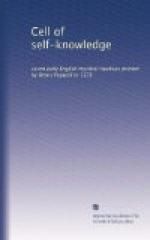Tantucci, Giovanni, xvii
Tyrrell, George, xxi n
Wyclif, 16 n, 79 n, 112 n
Wynkyn de Worde, xviii, xix, xx, xxi, xxvii
Zebulun, symbolism of, 6, 22-25
Zechariah, 119
Zilpah, symbolism of, 4-6, 15-17, 20
Footnotes:
[1] Dante, convivio, i. 12.
[2] Cf. the Letter to Can Grande (Epist. x. 28), where Dante, like St. Thomas Aquinas before him, refers to the Benjamin Major as “Richardus de Sancto Victore in libro De Contemplatione.”
[3]Par. x. 131, 132.
[4] Ps. lxviii. 27.
[5] Benjamin Minor, cap. 73.
[6] Benjamin Minor, cap. 75. Cf. Shelley, The Triumph of Life: “Their lore taught them not this: to know themselves.” This passage of Richard is curiously misquoted and its meaning perverted in Haureau, Histoire de la Philosophie Scolastique, i. pp. 513, 514, in the Dictionary of National Biography, vol. xvi., and elsewhere.
[7] Benjamin Minor, cap. 81.
[8] Cf. below, pp. 32, 33.
[9] Richard Rolle of Hampole and his Followers, edited by C. Horstman, vol. i. pp. 162-172.
[10] Sene, Senis, or Seenes, “Siena,” from the Latin Senae (Catharina de Senis).
[11] Cf. E. Gordon Duff, Hand-Lists of English Printers, 1501-1556, i. p. 24.
[12] Bibliotheca Britannico-Hibernica p. 452.
[13] Quietaclacmium Margerie filie Johannis Kempe de domibus in parochia de Northgate. Brit. Mus., Add Ms. 25,109.
[14] She was, however, apparently less strictly enclosed than was usual for an ancress.
[15] Cf. G. Tyrrell, Sixteen Revelations of Divine Love shewed to Mother Juliana of Norwich, Preface, p. v.
[16] In the British Museum copy of Pepwell’s volume, ff. 1-2 of the Epistle of Prayer and f. 1 of the Song of Angels are transposed.
[17] Cf. C. T. Martin, in Dictionary of National Biography, vol. ix. For Hilton’s alleged authorship of the De Imitatione Christi, see J. E. G. de Montmorency, Thomas a Kempis, his Age and Book, pp. 141-169.
[18] Edited by G. G. Perry, under the title The Anehede of Godd with mannis saule, as the work of Richard Rolle, in English Prose Treatises of Richard Rolle de Hampole (Early English Text Society, 1866), pp. 14-19; and, in two texts, by C. Horstman, op. cit., vol. i. pp. 175-182.
[19] In the MSS. this is called: A pystyll of discrecion in knowenge of spirites; or: A tretis of discrescyon of spirites.
[20] All in Harl. Ms. 674, and other MSS. The Divine Cloud of Unknowing, and portions of the Epistle, Book, or Treatise, of Privy Counsel have been printed, in a very unsatisfactory manner, in The Divine Cloud with notes and a Preface by Father Augustine Baker, O.S.B. Edited by Henry Collins. London, 1871.
[21] D. M. M’Intyre, The Cloud of Unknowing, in the Expositor, series vii. vol. 4 (1907). Dr. Rufus M. Jones, Studies in Mystical Religion, p. 336, regards these treatises as the work of “a school of mystics gathered about the writer of the Hid Divinity.” Neither of these authors includes the translation of the Benjamin Minor, which, however, appears to me undoubtedly from the same hand as that of the Divine Cloud.




